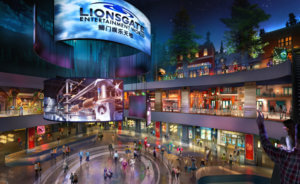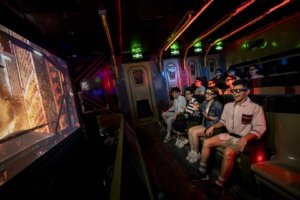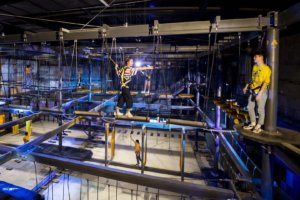Lionsgate Entertainment World: A Year of Many “Firsts”
- Blog Posts
One year ago, on July 31st, 2019, Lionsgate Entertainment World in Zhuhai, China opened its doors to the world. Created in partnership between Thinkwell with film studio Lionsgate, developer Lai Sun of Hong Kong, and park operator Village Roadshow, this one-of-a-kind indoor theme park features twenty unique guest activities including rides, shows, attractions, and interactive experiences inspired by popular Lionsgate blockbuster film franchises The Hunger Games, The Twilight Saga, The Divergent Series, Now You See Me, Escape Plan, and Gods of Egypt. Thinkwell worked closely with computer animation house Framestore, VR attraction groups CAVU Designwerks and Dreamcraft Attractions, and many other global partners to bring the park to life.
To celebrate the first anniversary of that achievement, as well as the park’s recent June 2020 reopening under revised health and safety guidelines, we’ll take a look back at the extraordinary number of worldwide “firsts” Lionsgate Entertainment World represented.
 Foremost among these “firsts” was that Lionsgate Entertainment World became the world’s first vertical theme park, at nearly 250,000 square feet (24,000 square meters) stacked over four levels.
Foremost among these “firsts” was that Lionsgate Entertainment World became the world’s first vertical theme park, at nearly 250,000 square feet (24,000 square meters) stacked over four levels.
What exactly does a vertical theme park mean? The concept isn’t entirely without precedent—other theme parks have included multi-level indoor zones, and several urban entertainment centers have included a mix of interactive experiences within a vertical design. But Lionsgate Entertainment World was the first to take the kinds of immersive environments and signature attractions you’d find at a major theme park, including roller coasters and dark rides, and design the entire experience within a 100% vertical framework.
This verticality required a radically different approach to many of the fundamentals of theme park design, particularly to the organization of the park and its theme zones. Many theme parks use a “hub and spoke” master plan to orient guests within the park, in which the various themed environments are organized radially around a central icon, allowing guests to intuitively orient themselves within the park.
The solution was to re-imagine the hub as an immense central atrium connecting all of the levels, by which guests could visually orient and physically move throughout the vertical space. The icon that attracts guests to this central space had to likewise fit the unique vertical philosophy of the park. Dubbed the “media chandelier,” this icon boasts a three-story, eight-ton, cylindrically shaped media installation using eight curved LED screens that are in constant motion. The glass and metal surfaces surrounding the atrium reflect the dynamic media, creating a 360-degree experience that’s not only an engineering marvel but also a mesmerizing sight to behold.

Lionsgate Entertainment World also provided an excellent opportunity to experiment with new technologies and storytelling techniques that could take advantage of the stacked vertical space. Engineering a vertical theme park meant that traditional large iron rides weren’t feasible, so Thinkwell had to devise more innovative media- and story-driven experiences to thrill its audience… which created many more “firsts” along the way!
Attractions based on virtual reality and gamified interactives, often associated with lower capacity upcharge experiences at theme parks, here are not only included in the base ticket price but serve as flagship experiences to represent Lionsgate’s most important franchises. These include The Twilight Saga: Midnight Ride, the world’s first high capacity interactive virtual reality experience to open as a major theme park attraction and the world’s first purpose-built VR roller coaster, Gods of Egypt: Battle for Eternity, that uses its vertical space limitations to its advantage.
Additional innovations in the park were realized when creating a 4D simulator ride based on The Hunger Games franchise. Mockingjay Flight Rebel Escape provided new 3D layering illusions and in-cabin effects. For the media-enhanced dark ride The Twilight Saga: Bella’s Journey, Thinkwell’s design and production team combined squinching media, animatronics, mapped projections, and physical scenery to create an incredible retelling of Bella’s story from the blockbuster film.

Yet other attractions were the first to use technology or interactive concepts as part of a signature theme park experience, from high-tech escape rooms (Escape Plan: Prison Break), a team-based VR walkthrough experience (Divergent: Dauntless Fear Simulator), and countless smaller gamified digital interactive experiences hidden throughout the themed environments.
The park’s dining and retail offerings are just as experiential, whether it’s getting a makeover at Capitol Couture & Cosmetics from The Hunger Games, or solving a mystery with media and magic while grabbing a drink in the Oculus Lounge, based on the Now You See Me franchise. Collectively, the experiences at Lionsgate Entertainment World represent perhaps the biggest achievement: to integrate a deep level of participatory, technology-enhanced interaction within the entire theme park design, representing the first-of-its-kind in an entirely new genre of immersive themed entertainment.
That’s a lot of firsts for a single theme park to achieve in its first year of operation, yet as we celebrate one year of Lionsgate Entertainment World, and reflect on all the ups and downs the world has seen during that time, we know that it isn’t so much the primacy of “being first” that’s important, but the inspiration it gives to those who might follow.
Related Posts
Thinkwellians Win Accolades
- Blog Posts
- News
- Subject Matter Expert
Thinkwell (a TAIT company) congratulates its team members Thomas Jakobson...
Embracing AI
- Blog Posts
Whether we like it as a tool or fear that...
Welcome to Kansas City!
- Blog Posts
Welcome, TEA, to my stomping grounds. Yeah, I’m a Chicagoan...